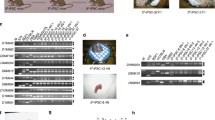Abstract
We report transgenic mouse models in which three or four reprogramming factors are expressed from a single genomic locus using a drug-inducible transgene. Multiple somatic cell types can be directly reprogrammed to generate induced pluripotent stem cells (iPSCs) by culture in doxycycline. Because reprogramming factors are carried on a single polycistronic construct, the mice can be easily maintained, and the transgene can be easily transferred into other genetic backgrounds.



Similar content being viewed by others
References
Takahashi, K. & Yamanaka, S. Cell 126, 663–676 (2006).
Okita, K., Ichisaka, T. & Yamanaka, S. Nature 448, 313–317 (2007).
Wernig, M. et al. Nature 448, 318–324 (2007).
Maherali, N. et al. Cell Stem Cell 1, 55–70 (2007).
Hanna, J. et al. Cell 133, 250–264 (2008).
Wernig, M. et al. Nat. Biotechnol. 26, 916–924 (2008).
Maherali, N. et al. Cell Stem Cell 3, 340–345 (2008).
Hockemeyer, D. et al. Cell Stem Cell 3, 346–353 (2008).
Markoulaki, S. et al. Nat. Biotechnol. 27, 169–171 (2009).
Hochedlinger, K., Yamada, Y., Beard, C. & Jaenisch, R. Cell 121, 465–477 (2005).
Beard, C., Hochedlinger, K., Plath, K., Wutz, A. & Jaenisch, R. Genesis 44, 23–28 (2006).
Carey, B.W. et al. Proc. Natl. Acad. Sci. USA 106, 157–162 (2009).
Soldner, F. et al. Cell 136, 964–977 (2009).
Kaji, K. et al. Nature 458, 771–775 (2009).
Woltjen, K. et al. Nature 458, 766–770 (2009).
Yusa, K. et al. Nat. Methods 6, 363–369 (2009).
Acknowledgements
B.W.C. thanks C. Lengner and L. Lee-Houghton for advice and assistance on somatic cell isolation techniques. We thank F. Edenhofer (University of Bonn Medical Center) for a gift of purified recombinant HTN-Cre protein, and J. Dousman and R. Flannery for mouse husbandry. J.H. is supported by a fellowship from the Helen Hay Whitney Foundation. R.J. is supported by grants from the US National Institutes of Health (5-RO1-HDO45022, 5-R37-CA084198 and 5-RO1-CA087869).
Author information
Authors and Affiliations
Contributions
B.W.C. designed and performed experiments, analyzed data and wrote the paper. S.M. performed all blastocyst injections. J.H. assisted in experiments. C.B. assisted in design of Col1a1 targeting vectors. R.J. participated in experimental design, interpreted data and assisted in writing the paper.
Corresponding author
Ethics declarations
Competing interests
R.J. is an advisor to Stemgent and a co-founder of Fate Therapeutics.
Supplementary information
Supplementary Text and Figures
Supplementary Figures 1–6 and Supplementary Tables 1–5 (PDF 5348 kb)
Rights and permissions
About this article
Cite this article
Carey, B., Markoulaki, S., Beard, C. et al. Single-gene transgenic mouse strains for reprogramming adult somatic cells. Nat Methods 7, 56–59 (2010). https://doi.org/10.1038/nmeth.1410
Received:
Accepted:
Published:
Issue Date:
DOI: https://doi.org/10.1038/nmeth.1410
- Springer Nature America, Inc.
This article is cited by
-
Restoration of neuronal progenitors by partial reprogramming in the aged neurogenic niche
Nature Aging (2024)
-
In vivo reprogramming leads to premature death linked to hepatic and intestinal failure
Nature Aging (2023)
-
RSL24D1 sustains steady-state ribosome biogenesis and pluripotency translational programs in embryonic stem cells
Nature Communications (2023)
-
Comparative roadmaps of reprogramming and oncogenic transformation identify Bcl11b and Atoh8 as broad regulators of cellular plasticity
Nature Cell Biology (2022)
-
The H2B ubiquitin-protein ligase RNF40 is required for somatic cell reprogramming
Cell Death & Disease (2020)





